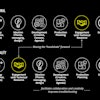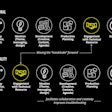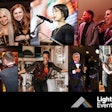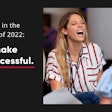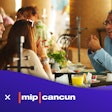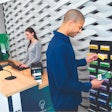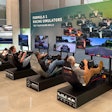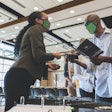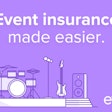1. Zkipster
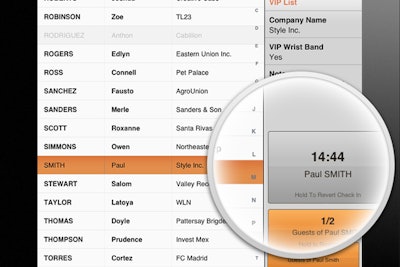
Zkipster is a service to manage guest check-in on iPads at private events. It launched last year in the United States following a European debut in 2011. Users upload their guest list on a Web platform and then access it at the event through an iPad app; it takes an average time of two seconds to check in a guest at an event with 750 people. Hosts can edit the guest list in real time and send email and text alerts when specific guests arrive. After the event, the system can generate data such as the time that people arrived, which can be helpful when planning staffing for future events. Clients include Hearst, HBO, Hugo Boss, and the Whitney Museum. Future updates will allow each guest to be identified with a photo rather than just a name. Pricing can be done on a per-event basis for $75 or as a subscription for $750 for four months or $2,000 per year.
Photo: Courtesy of Zkipster
2. Blyve
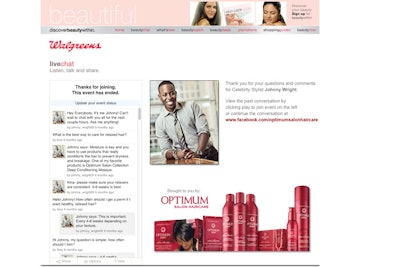
Blyve is a platform for live online events. The system is intended for companies to host interactive online events: for example to launch a new product, share educational information, or conduct training. Walgreens has used Blyve to host an interactive chat on beauty tips, with the link to the chat embedded on the Walgreens Web site. The system has interactive features such as polls and moderated Q&A functions. A Twitter widget allows hosts to search for tweets about the online event and then invite the people who tweeted to join the conversation. The platform can also integrate media from Ustream, YouTube, Instagram, and other services. Hosts can use the platform to generate revenue by including ads or offers from sponsors. Pricing is either per event or, for recurring events, based on the number of participants.
Photo: Courtesy of Blyve
3. Postano
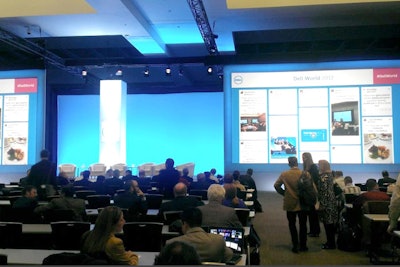
Postano is a tool used to display social media feeds online or at an event. The system aggregates content from Twitter, Facebook, Instagram, YouTube, Tumblr, Pinterest, and more based on specific account names or hashtags. Hosts can monitor the content before it is shared through the system or have it instantly displayed. The Postano display can be designed with custom colors, logos, and animations, and it can be shared through Facebook, a Lightbox widget, on a large screen, or on a touch-screen monitor. At Dell World in December the company used Postano to display a live feed of content from several conference hashtags during remarks from C.E.O. Michael Dell and elsewhere at the event. Additional Postano clients include Tiffany & Company, Microsoft, and Nine West. Pricing starts at $5,000.
Photo: Courtesy of Postano
4. Emobile
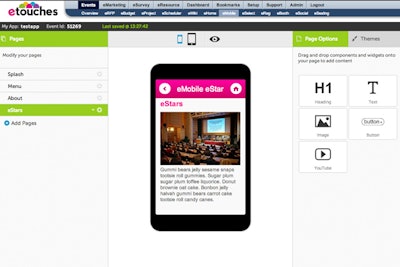
Emobile is the newest product in the suite of event management software from Etouches. The tool allows users to design, test, and publish their own Web-based mobile app through a simple drag-and-drop interface. The product is integrated with other software from the company so planners can import data such as agendas and directories of speakers and attendees. In addition, attendees can use the app to communicate with one another. For now, Emobile creates a Web app that can be downloaded by scanning a QR code. In April it will become available as a mobile app for iOS, Android, and other platforms. The product is a $500 add-on to the Etouches software package.
Photo: Courtesy of Etouches
5. EventMobi
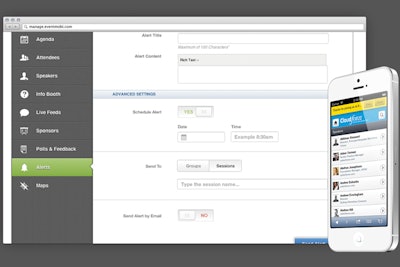
When EventMobi launched in 2009 as one of the first do-it-yourself app creators, it was primarily a digital show guide. Since then it has been updated with interactive features. The latest updates, which begin rolling out in February, will give planners the ability to communicate with subsets of attendees—for example, to invite V.I.P.s to a private dinner or send an alert to all exhibitors. EventMobi is also adding a private real-time chat function for attendees so they can use the app to initiate meetings or networking.
Photo: Courtesy of EventMobi
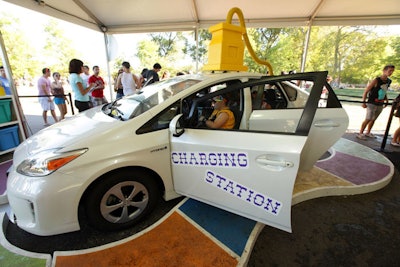
The Toyota Prius activation in Chicago's Grant Park for Lollapalooza this year offered a model car that doubled as a charging station. Inside the vehicle as many as five festival-goers could recharge their gadgets.
Photo: Barry Brecheisen for BizBash
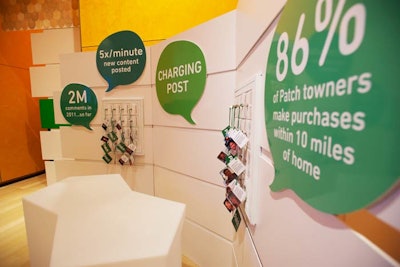
In an effort to promote its news site Patch.com, Ad Week sponsor AOL installed lockers inside New York's TimesCenter in October last year. The station—dubbed the "charging post"—allowed executives to drop off their gadgets for recharging and claim them later.
Photo: Brian Virgo/AOL
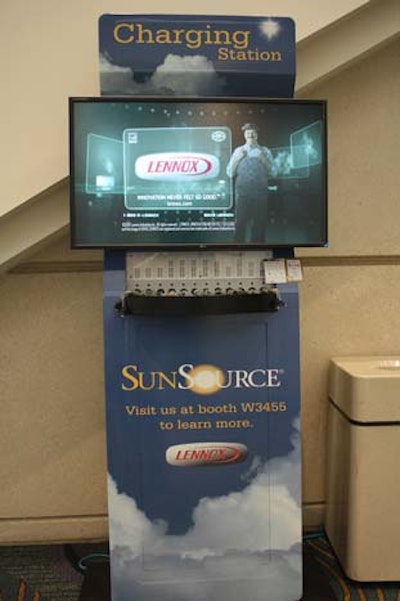
At the 2012 International Builders' Show in Orlando, phone charging stations positioned throughout the concourse of the Orange County Convention Center also showed videos from the expo's sponsors.
Photo: Mitra Sorrells/BizBash
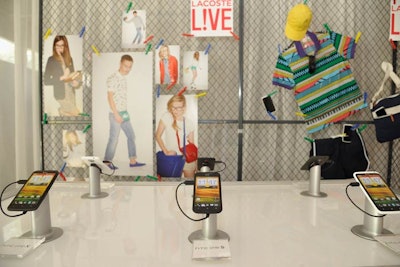
During Coachella this year, Lacoste hosted two days of pool parties at a private estate in Thermal near the festival's Indio, California grounds. Sponsored by HTC, the festivities included a place where guests could charge electronic devices while participating in activities like giant Twister and speedboat racing.
Photo: John Sciulli/WireImage
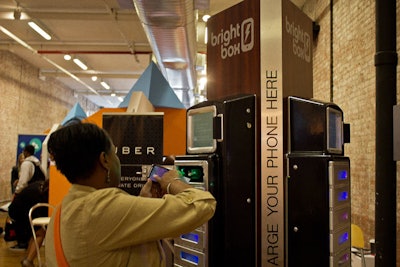
At the May iteration of Internet Week in New York, Brightbox stations positioned around the venue allowed conference attendees to quickly and conveniently recharge their cellphones between sessions.
Photo: Nadia Chaudhury/BizBash
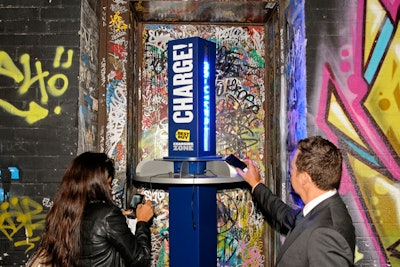
Outside the "Goodnight Gansevoort" lounge—a late-night space hosted by the Gansevoort Hotel Group—attendees of the 2011 Toronto International Film Festival could recharge their electronics in the Best Buy charging zone.
Photo: David Lee/Getty Images
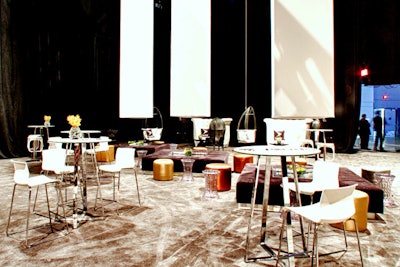
As part of its event for the 2011 International C.T.I.A. Wireless show in Orlando, Sprint created a movie-theater-style lounge in which 30-foot-tall columns functioned as phone charging stations and as projection screens for Sprint products.
Photo: Orlando Convention Photographers
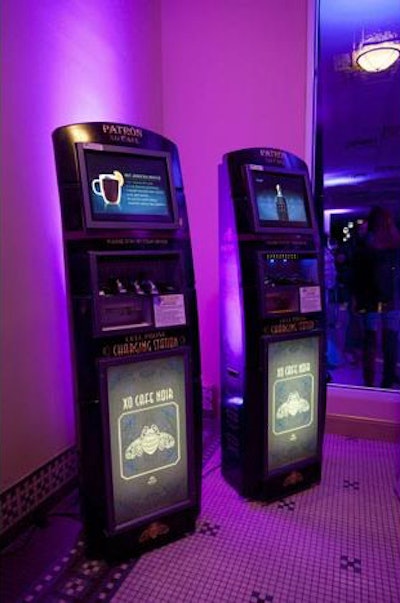
In November 2011, Patrón hosted an event in Orlando to promote its XO Café Noir to musicians and industry executives in town for the Orlando Calling music festival. Inside the party, the spirits company offered GoCharge phone charging stations from Hercules Networks, where guests could leave their phones with a staff member to charge.
Photo: Angel Tagudin
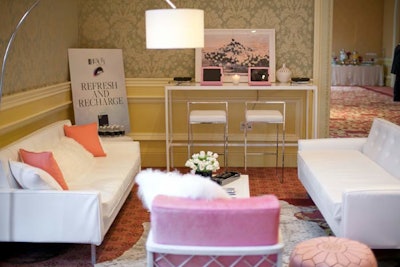
This May, WWD hosted its C.E.O. Beauty Summit in Miami, bringing 280 executives in the beauty industry to town for a three-day discussion. During networking breaks and between sessions, attendees could charge their devices in the dedicated "refresh and recharge" lounge.
Photo: Sonja Garnitschnig
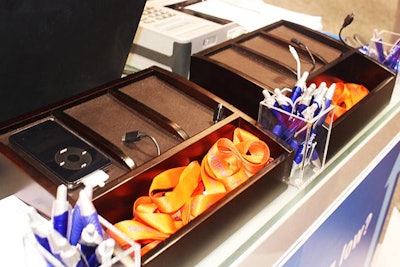
For the Healthcare Information and Management Systems Conference in 2011, MedQuist's booth offered spots for charging iPods and cell phones. While attendees waited, the company's staff took the opportunity to talk to them about its products.
Photo: Mitra Sorrells/BizBash
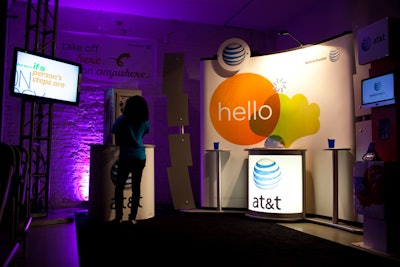
Last year the Dumbo Arts Festival was able to expand its roster of activities to include tech-based elements through sponsor AT&T. Among the offerings was a phone charging area inside festival's lounge in Brooklyn.
Photo: Caleb Ferguson for BizBash
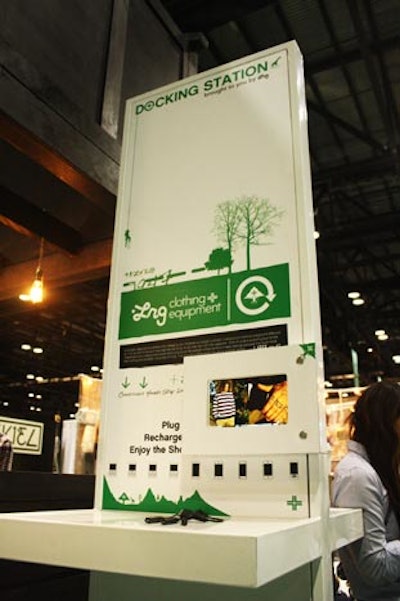
At the Surf Expo Show in Orlando in January, LRG had a docking station with eight different phone chargers compatible with iPhone, Android, and BlackBerry devices. The freestanding kiosk also displayed videos of the clothing and accessories company's wares.
Photo: Mitra Sorrells/BizBash
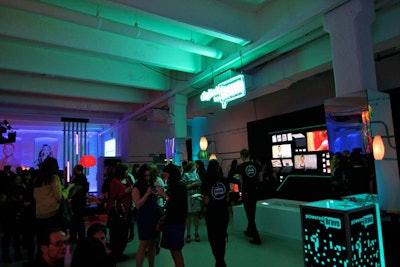
Looking to reinforce the importance of digital media to its brand, Bravo's New York upfront event in April had a space called "Digital World" that included TV screens, latops, iPhones, and iPads. For guests, there was a phone charging station as well as a spot that printed images posted on Instagram.
Photo: Courtesy of MB Productions
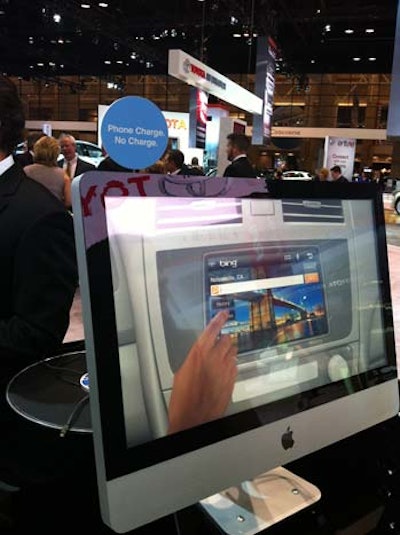
Toyota’s exhibit area at the Chicago Auto Show included Apple desktop computers that functioned as charging stations and displayed Toyota commercials to keep visitors entertained.
Photo: Jenny Berg/BizBash
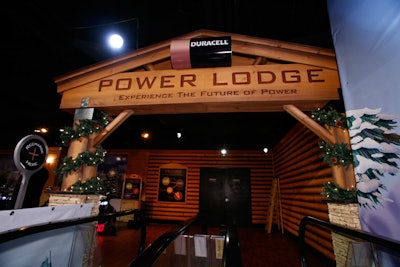
Duracell's "Power Lodge" pop-up in 2008 invited the public to help power the New Year's sign in Times Square with bicycles. The promotion also included an area where visitors could charge cell phones, iPods, and other personal electronics, as well as play with toys powered by the battery brand.
Photo: Stuart Ramson

